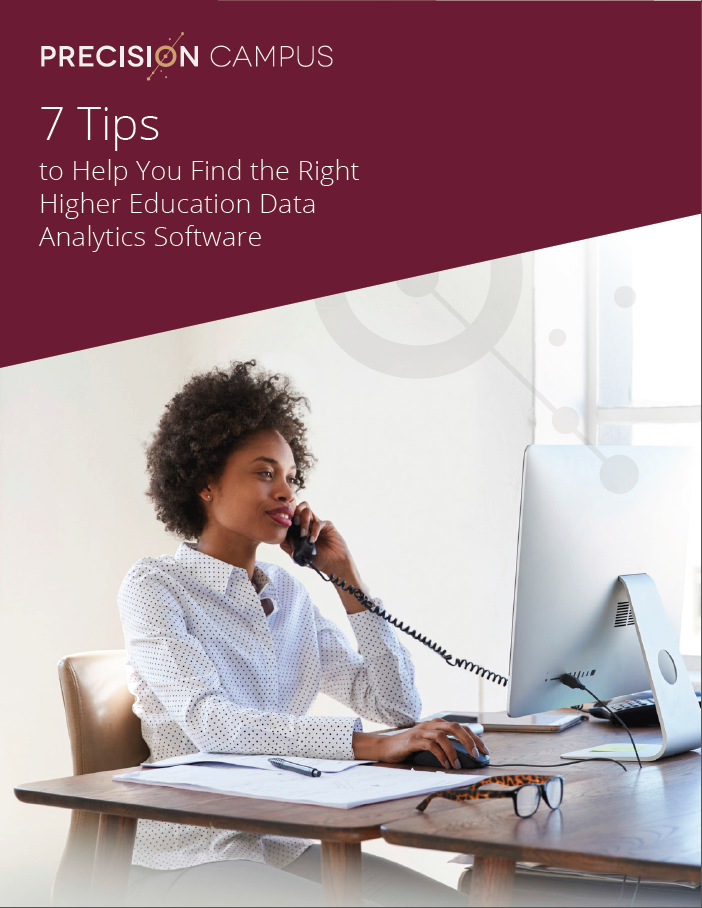Digital transformation is revolutionizing the way businesses approach their operations, product and service offerings, marketing efforts and every other facet of their organization. Higher education is one of the biggest industries that is well-positioned to derive considerable benefits from digital transformation.
In this article, we take a deep dive into the world of digital transformation in higher education, specifically looking at the following areas:
What is Digital Transformation?
How Digital Transformation Relates to Higher Education
4 Goals of Digital Transformation in Higher Education
5 Tips for Implementing a Digital Transformation Strategy
3 Digital Transformation Examples
8 Digital Transformation Trends in Higher Education
What is Digital Transformation?
Digital transformation refers to the evolution of an organization’s foundational business practices using technology and data. Essentially, digital transformation is a total business transformation.
There are successful examples of digital transformation across every industry. The healthcare field is one in particular to note. Several years ago, practices were required by law to migrate all paper and manual record keeping into electronic health records. The end result has made it possible for patients to access their medical records from the comfort of their home, and healthcare administrators have a much more organized, modernized system to work with.
How Digital Transformation Relates to Higher Education
Ultimately, the goal of digital transformation is to better serve customers and streamline business operations.
In higher education, the customers are the students and they have an immense amount of learning options to choose from — private vs. public schools, online vs. on-campus learning and full-time vs. part-time enrollment.
From 2005 to 2016, the National Center for Education Statistics reports that the number of post-secondary institutions in the United States increased by nearly 10%.
And with more options than ever before, college and university leaders are struggling to maintain a competitive edge, which is even more concerning when you take into account the declining rate of high school graduates. As Forbes reports, the number of high school graduates has decreased across most of the country every year and won’t see an increase until 2024.
So how can a university keep up? Digital transformation.
Why Higher Education Needs Digital Transformation
There’s no such thing as a traditional student anymore. It’s more common for a student to balance work, family and school on a day-to-day basis than for one to be on campus full time with a sole focus on going to class.
That’s where digital transformation comes in. By leveraging technology and data, institutions can:
- Use digital avenues like social media, websites, email marketing and more to recruit and retain students.
- Measure institutional success and make data-driven decisions using big data.
- Digitize library resources so they are available online and for more than one student at a time.
- Create mobile apps to keep students updated on campus events, news and more.
These are only a small sample of what’s possible with digital transformation in higher education. So even though there is less customer (student) demand and there are more learning options to choose from, colleges and universities can differentiate themselves and gain a competitive advantage by re-evaluating their technology and data practices.
4 Primary Goals of Digital Transformation in Higher Education
Before any institution can implement a successful digital transformation strategy, they need concrete goals to work toward.
Changing a business in any way requires sincere effort, and without solid goals in mind you won’t be able to know for certain whether your hard work was worth it.
Every college and university will have a different area they want to focus on first, but some of the primary goals of digital transformation for higher education include:
- Enhance Student Experiences: This focuses on improving student metrics like retention and graduation rates, course success rates and other markers that prove overall success.
- Improve Competitiveness: This goal focuses on differentiating an institution from the competition by using digital avenues.
- Create a Culture of Data-Driven Decision Making: This includes adopting a digital mindset across all areas of the campus for students, faculty, leadership and other staff members.
- Optimize Resources: This covers everything from improving communication between administrators to cutting costs related to electricity usage.
5 Tips for Implementing a Digital Transformation Strategy
- Welcome the Change
The education industry is a prime example of how some businesses can be reluctant to embrace change.Leadership, administrators, faculty and other institutional staff members often like to stay tucked in their comfort zone, making it hard to introduce new technologies or skillsets. But standing still is not an option anymore. To drive your institution forward, everyone needs to be on board and ready to welcome the much-needed change.
- Pick a Direction
As mentioned, there are a few common goals specific to digital transformation for higher education. And while every institution wants to achieve all of them, you need to start small.Here’s an example: If your goal is to aggregate all institutional data under one system, first you’ll need a strategy. You’ll need to take a look at your inefficiencies, the disparate systems across campus and the technology, methodology and skills you need to achieve your goal.
- Check Your Current Systems
Every school already has some type of technology in place. But if you’re looking to upgrade during your digital transformation, you need to make sure your existing systems will be compatible with anything new you’re bringing on.
- Say No to Silos
With our culture of big data, every college, department, program, class and student comes with a ton of valuable information attached. Analyzing this data can unlock solutions to operational inefficiencies, poor success rates and other problem areas.But if data is siloed, this isn’t possible. It’s all too common for the math department to have a completely different data system and process than the English department, but how does that affect the institution as a whole? Leadership can’t make the data-driven decisions that digital transformation makes possible without organized, unified data.
- Automate Wherever You Can
Digital transformation will open up more opportunities for your school, but it’s entirely possible to become overwhelmed by all the new capabilities.Fortunately, time-consuming tasks like workflow management or sending daily status emails can all be automated with digital transformation. One especially beneficial automation tactic is with data collection and management, which can alleviate some stress your institutional research department may be having.
3 Digital Transformation Examples
Studying & Notetaking
Campuses are working to improve retention and graduation rates by adding interactive whiteboard displays that provide students with a digital copy of the instructor’s notes during each class. Since these displays are connected to the internet, instructors can also utilize more resources during a lesson, like maps, additional data and online information.
Students can also benefit when they’re on the go. Mobile apps allow students to scan images and text from any document, including books they might not be able to check out at the library. This also eliminates the need for making photocopies, which reduces paper waste and can support any on-campus “green” initiatives you have.
Digital Payment Options
A large portion of banking is now done online and via mobile apps, so it makes sense for colleges and universities to adapt. Students waiting for financial aid or work study checks probably need the cash as soon as possible. With a digital process, there’s no need to wait for a check to come in the mail and then head to the bank to make a deposit.
Many schools are also becoming cashless campuses by allowing payment for food, school supplies and other on-campus items via mobile apps or student ID cards.
Data-Driven Decision Making
The biggest benefit of any digital transformation strategy is the data that automatically comes with it. Digital in this instance means measurable, because your data can tell you whether a certain strategy is a success or not.
For example, think of a digital whiteboard display in a classroom. After every class, the instructor’s notes can be automatically emailed to students. But if your automated data analytics reveal that no one is opening the emails in a certain class, this might not be a very valuable effort.
8 Digital Transformation Trends
eLearning Industry notes that there are two main business areas that digital transformation is affecting:
- Services: This transformation involves creating new products and changing existing ones. Examples include offering an online MBA program or migrating from using tangible textbooks to digital eBooks.
- Operations: Processes are going completely digital. Examples here include applying for admission or graduation, registering for courses every semester and monitoring resource allocation using modern technology.
But how are colleges and universities putting their digital transformation strategies into action? eLearning Industry explains with the following trends:
- The Internet of Things (IoT)
The IoT refers to the extension of internet access to devices and everyday items, like a Fitbit fitness tracker.Schools can use the IoT to better allocate campus resources by installing devices like intelligent thermostats and lighting. These smart devices can detect occupancy and adjust settings accordingly to eliminate wasted electricity.
- Security
With so much student data available, security is a top concern — especially since IoT devices are expanding the reach and amount of information that can be collected. Institutions are installing new tools to enhance cybersecurity, most notably user and entity behavior analytics to detect suspicious activities.
- Augmented Reality & Virtual Reality
Classroom learning can mimic hands-on experience through augmented reality (AR) and virtual reality (VR). These technologies can put architect students right in the middle of a construction site or bring medical students inside of a hospital.
- Blockchain Technology
Known for making Bitcoin possible, blockchain offers exceptional security. According to Forbes, “blockchain is a public ledger that automatically records and verifies transactions … and operates through a decentralized platform making it fraud resistant.”In higher education, blockchain is being used to:- Verify academic credentials
- Share student records
- Secure infrastructure networks from hackers
- Access employment and criminal records
- Artificial Intelligence & Machine Learning
Artificial intelligence (AI) tools can be set up around campuses to answer simple student questions, like where the library is or what time the cafeteria closes. This can be especially impactful for first-year students who are still finding their bearings.
- Chatbots
The University of St. Thomas offers a website widget that lets students chat with librarians and ask questions about basic research topics, eliminating the need for them to go to the library or pick up the phone. This practice can be utilized across any department to streamline processes like making appointments, requesting dorm room maintenance or checking on financial matters.
- ADA Compliance
Making education accessible to everyone is an absolute must under the Americans with Disabilities Act (ADA), and digital transformation is helping colleges and universities go above and beyond. Tools designed for transcription services can help hearing-impaired students easily understand an entire lecture.
- Big Data Analytics
Technology has fast-tracked the amount of data colleges and universities collect, and digital transformation is all about using it to your advantage. Institutions are using data analytics platforms to collect, manage, analyze and share reports for crucial metrics like student success rates and retention rates. With the help of an automated and secure analytics program, making data-driven decisions can become the foundation of your digital transformation.



